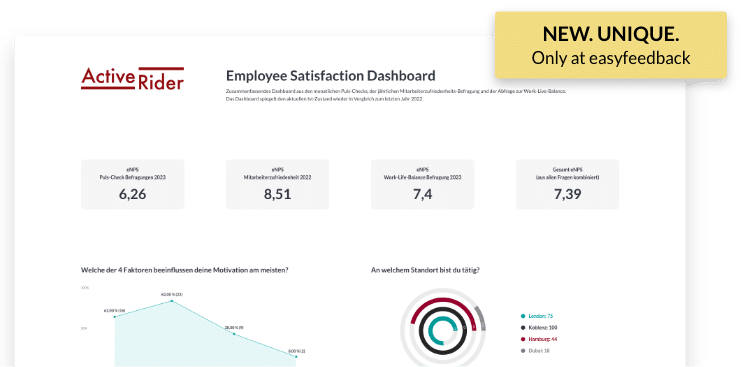Mood meter - the short feedback from colleagues

Find out how your employees' workday was and what kind of mood they go home with. Our ready-made survey template can help you strengthen employee loyalty and reduce turnover rates.

“Identifying customer needs is an essential part of our business. easyfeedback accompanies us for many years as a loyal partner in this task. We particularly appreciate the intuitive usability of the survey tool as well as the professional support.“
Guild Lead User Experience Research

“We use easyfeedback for internal and external surveys – fast, comfortable and really easy! Straightforward and cordial support can always create a smile. We really appreciate the permanent development of the platform.“
Guest & Competitor Insights Analyst
Content and targets of this mood meter template
Do you know how your employees’ working day went? What is their mood when they leave their workplace?
A short and anonymous survey before the end of work or in the morning allows you to easily find out the current mood of your employees.
Find out what went well and what went badly, whether there were points of friction in the team or what obstacles arose in the accomplishment of tasks. With this short survey, you will learn what ultimately led to the employee’s mood at the end of the workday.
Additionally, as a manager and company, you give your employees the feeling that you are valued and interested in their health well-being.
But employees also benefit from a mood meter. It gives them the chance to be heard by giving honest feedback through the anonymity of the survey.
Therefore, take the opportunity through a short feedback to give employees an ear, to bring the working atmosphere to a new level and to strengthen team and employee loyalty.
Establish a regular mood barometer in your company as well.
Content:
• Recording the daily mood of employees
• Reflection of a working day
• Evaluate communication and collaboration
• Learn what went well & what went badly in the daily work routine
Goals:
• Increase employee satisfaction & motivation
• Strengthen team building & cooperation
• Improve work & work climate
• Early prevention of problems & conflicts
• Strengthen employee loyalty & employer brand
• Reduce employee turnover
• Optimize leadership qualities
• Observe changed processes & ways of working

Data privacy protection „made in Germany“ (GDPR)

Anonymity functions for open feedback
Almost everything you need to know about the mood meter
1. What is a mood meter?
A mood barometer is a short survey, usually in the form of a ranking or scaling question, in which a group of people are asked about their current state of mind.
Often used in the context of schools, the mood barometer is also becoming increasingly popular as a reflection and satisfaction survey at events and in companies.
Particularly in companies, it can be a valuable tool as a daily survey, for example, to anonymously inquire about the current working and work climate, to initiate improvements and thus to reduce the fluctuation rate.
2. What is a mood barometer used for in the company?
A mood barometer can be used in many different areas of a company.
For example, you would like to know how the working atmosphere is currently in your department or company?
Then the mood barometer can be a valuable tool for, on the one hand, asking about the well-being of employees in a quick and anonymous way. On the other hand, with one or two clever questions, you can also find out the reasons for the current emotional state. For example, ask what went well and what went poorly during the current workday.
This can provide information about whether there are conflicts and tensions between employees, for example, or obstacles in accomplishing tasks. This information will help you find goal-oriented solutions and, in the event of conflicts within the team, raise the mood by taking countermeasures.
In addition to measuring the current working climate, mood barometers can also be used, for example, to test new or adapted working methods and work processes.
For this purpose, employees are asked anonymously about their impressions and overall feelings by means of a mood barometer.
Another example of the use of a mood meter can be to monitor the success of training or health-promoting programs.
3. What are the goals of a mood meter?
As already mentioned, a mood meter is a simple way to find out a person’s current emotional state.
However, this is not the only goal that can be achieved when conducting a mood barometer. In the following we have explained other goals in more detail:
1. Reduce employee turnover
Satisfied and good-humored employees remain loyal to their company longer. They think less about changing jobs.
But how do employees become happier? Ask about their mood, take an interest in them, build a relationship of trust. An employee who feels valued and whose opinion is heard shows a greater willingness to perform and is happier with his work.
This leads to fewer resignations, which in turn saves you time and costs, which are incurred, for example, by the recruiting process or by training new employees.
2. Increase work and company climate
By means of a daily survey on the mood of your employees, it is possible for you to record the current working and company climate and, if necessary, to influence it positively through regular team events or group discussions. This contributes significantly to a relaxed and pleasant working atmosphere.
If employees feel comfortable in your company, this has several advantages. On the one hand, a pleasant working environment has a positive effect on the feeling of belonging and cooperation within the team. Furthermore, the motivation of the employee increases, the quality of work improves and the work culture of the entire company gets a successful image, which also has a positive effect on the labor market.
3. Increase employer brand
Poor salary, lack of prospects, promotion and further training or insufficient work equipment are factors that have a negative impact on the attractiveness of an employer brand.
But not only the previously mentioned “hard” factors have an impact on the attractiveness of your company as an employer. “Soft” factors such as working climate, management style of superiors or an unbalanced work-life balance also have a major impact.
Also remember that employees and managers reflect the identity and lived values of your company. For example, if a supervisor’s management style is too harsh or inappropriate, it can contribute to employee dissatisfaction, which can also negatively impact your employer brand. Word can spread about dissatisfaction. If your employer brand suffers, you may find it more difficult to attract suitable staff and young talent in the future.
That’s why it’s important that you continuously measure employee satisfaction. If you don’t want the survey to be too large and require little effort, a daily survey using a mood meter can help.
With a mood meter, you can gather initial insights into where the emotional situation/mood is heading in your company, the department or with individual employees, so that you can react at an early stage by taking countermeasures.
Use the opportunity of a short survey by means of a mood barometer to strengthen your employer brand.
4. Develop managers
Feedback from employees also benefits managers. Thanks to feedback from your employees, managers continuously learn, recognize mistakes and can, for example, further develop their social skills as well as their leadership style.
Positive feedback can strengthen and motivate managers to maintain their leadership style.
5. Observe change processes
Every company needs to change and adapt over time. Whether due to internal reasons, such as the introduction of new ways of working, or due to external influences, such as increasing competitive pressure.
To secure the performance and future of a company, companies must be capable of change.
But change brings uncertainty. Especially for employees. They often feel disoriented and overwhelmed by the changes to routine processes and habits.
A mood barometer can help you involve your employees in change processes at an early stage and find out whether they can cope with the changes or whether the new procedures and work processes have complicated the handling of tasks.
4. What are the benefits of conducting a mood barometer for employers and employees?
Above all, supervisors and employers have a useful method with the mood barometer to measure the current mood of the workforce easily and quickly.
By inquiring about the emotional state of employees, employers feel valued as they show care and responsibility for them. Furthermore, frictions and conflicts in the team can be recognized more quickly and can be steered into a harmonious course through discussion rounds. In this way, you promote teamwork immensely.
Psychological workplace stress can also be detected early on by recording the mood and thus improve the working atmosphere. This helps companies in particular to increase their attractiveness as an employer and reduce employee resignations.
However, not only supervisors and employers benefit from conducting the mood barometer, but also the employees themselves. As already mentioned, they feel perceived and valued by being asked about their mood. They are pleased to feel that the employer cares about their health and listens to them. The anonymity of such a survey also allows them to express their honest opinion.
This kind of feedback promotes motivation, the culture of discussion and the working atmosphere.
5. How can the implementation of a mood meter work?
At best, conduct this short and anonymous feedback method at the end of each workday. Alternatively, do it in the morning at the start of work. Give your employees a few quiet minutes before the end of the day or in the morning to briefly reflect on how their workday went and their mood when they leave the workplace.
The manager takes a few minutes the next day to evaluate the feedback.
Through a roundtable discussion, problems and conflicts are discussed as a team. The manager does not judge, but supervises and leads the conversation. To ensure confidentiality and the anonymity of the survey, the manager should offer his or her employees the opportunity to talk about the situation in question in individual meetings as well.
6. Should an employee sentiment barometer be conducted anonymously?
The employee survey should definitely be conducted anonymously.
This way, you strengthen trust in the survey and the employee will give you more honest feedback. In this way, even unpleasant points are more likely to be addressed.
On the other hand, you ensure a higher acceptance of the survey. Involve stakeholders such as the works council, management or data protection officers in the mood barometer at an early stage. This has an additional effect on the acceptance and trust of the survey.
You are in professional company







easyfeedback welcomes more than 740.000 participants per month







